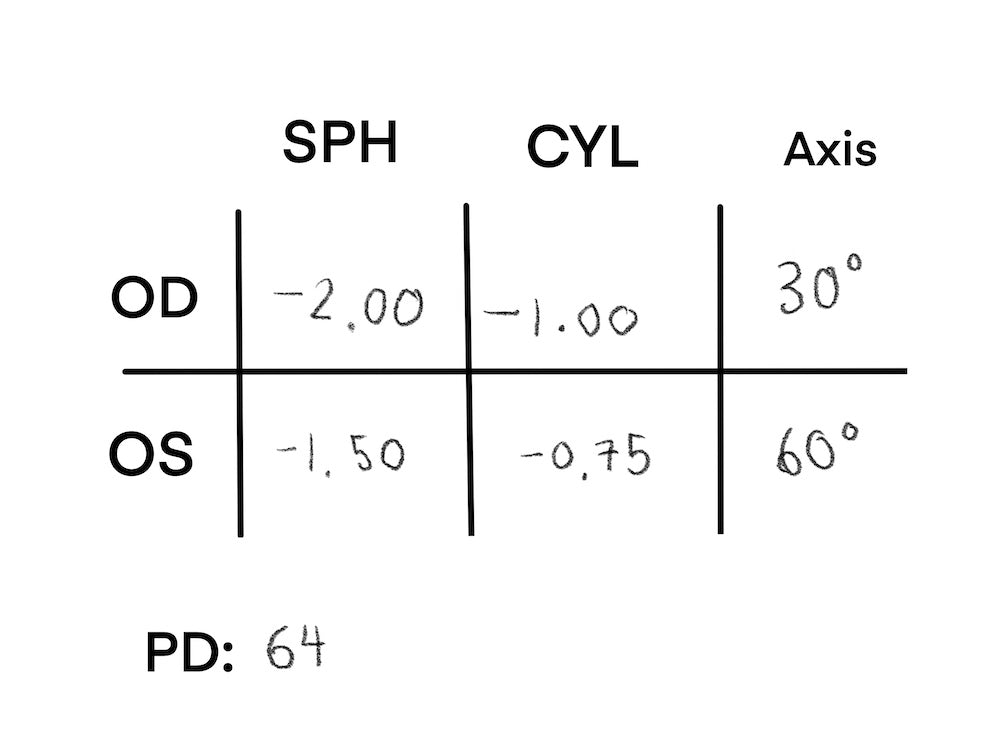How do you read your eye prescription?

In its simplest form, a prescription for glasses will feature a table with two rows and three columns.
The two rows refer to your right (OD) and left (OS) eyes with the right eye always on the upper row.
The three columns (from left to right) refer to Sphere (SPH), Cylinder (CYL) and Axis.
Sphere, also known as degree or power, is the amount of single vision correction you need. CYL is the amount of astigmatism correction you need, and Axis determines the lens angle required to correct your astigmatism.
If you require progressive lenses, your prescription will display a value under the ADD (addition) column.
In addition, most prescriptions will show your pupillary distance (PD), the horizontal distance between your pupils.
What do OD and OS mean?
OD is your right eye. OD stands for oculus dexter, the Latin term for “right eye.”
OS is your left eye. OS stands for oculus sinister, Latin for “left eye.”
What is the difference between SPH and CYL in a prescription?
SPH, or sphere, is the amount of lens power needed to correct nearsightedness or farsightedness, whereas CYL, or cylinder, is the amount of lens power needed to correct astigmatism.
When people talk about their eye degree or “power,” they are usually referring to their SPH value.
What does SPH (sphere) mean in a prescription?
SPH, or sphere, refers to the amount of correction needed for nearsightedness or farsightedness.
Optometrists measure SPH values in increments of 0.25 diopters, and when people talk about their prescription degree, they’re usually talking about their sphere value.
The plus (+) or minus (-) sign before SPH indicates whether you are nearsighted or farsighted. If your SPH value is -1.00, you are nearsighted. On the other hand, if your SPH value is +1.00, you are farsighted and need correction for seeing closer objects.
What does CYL (cylinder) mean in a prescription?
CYL, or cylinder, refers to the amount of astigmatism correction you need.
Similar to SPH, optometrists measure CYL in increments of 0.25 diopters.
If nothing appears in your CYL column, you do not require astigmatism correction. However, if you have a CYL value, you must have a corresponding Axis value.
What is astigmatism?
Astigmatism relates to an issue in the curvature of your cornea that causes blurred distance and near vision, especially at night.
If you suffer from astigmatism, your prescription will indicate values for CYL and Axis.
What does Axis mean in a prescription?
Axis refers to an angle value between 0 and 180 that determines the angle of the cylinder correction for astigmatism.
If your prescription indicates a CYL value, you must have a corresponding Axis value. Conversely, if your prescription does not display a CYL value, you do not need an Axis value.
What does ADD (addition) mean in a prescription?
ADD, or addition, refers to the amount of magnifying power you would need in multifocal lenses to see closer objects, like a book.
Like SPH and CYL, optometrists measure ADD in increments of 0.25 diopters. ADD is always a positive number and ranges from +0.75 to +3.00 for most people.
Can eyeglass prescriptions be used to buy contact lenses?
No, you cannot use your eyeglass prescription to buy contact lenses or vice versa because eyeglass lenses sit about 12 to 15 mm away from your eyes, whereas contact lenses are directly on your eyes.
In other words, because eyeglasses and contact lenses have different distances from your eyes, the amount of correction needed is also different.
How long does it take for prescription glasses to be ready?
Most of our prescription orders take about three days to complete. However, for complex prescriptions, such as when your SPH or CYL values fall beyond the average range, prescription orders can take up to 9 days to complete because optical labs will need to make custom-edged lenses for you.
